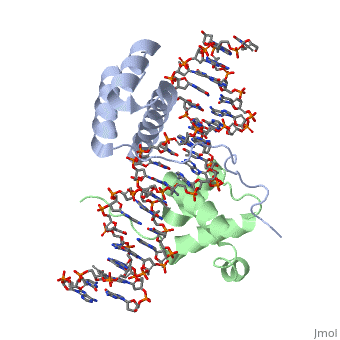This is a default text for your page Tyrone Evans Hox Proteins sandbox. Click above on edit this page to modify. Be careful with the < and > signs.
You may include any references to papers as in: the use of JSmol in Proteopedia [1] or to the article describing Jmol [2] to the rescue.
Introduction
Hox Proteins are transcription factors, proteins that are involved in the process of translating, or transcribing, DNA into RNA. These specific types of proteins are capable of binding to enhancers, a short (50-1500 bp) region of DNA, in pursuit of activating or repressing certain genes. These proteins are named this way because of the mutations that are done within them that cause homeotic transformations, changing of an organ into another.
Classification
If proteins have a major amount of similarity between their sequences, then they are believed to have similar functionality. In hox proteins, if they have parallel homeodomains then the specifics on how these proteins bind with DNA should be identical. But in order to tell the difference between the alike species, three types of classification are used: 1.) Phylogentic Inference Based, 2.) Synteny-Based, and 3.) Sequence Similarity-Based. The Phylogentic Inference Based classification method is used to show shared and unshared characteristics. Synteny-Based classification is a method of tracking mutations in comparable given sequences. The final method of classification, Sequence Similarity-Based, is used for identifying “homologous” or related proteins and genes.
Hox Protein Regualtion
Hox genes, which hold the instructions for how each protein should be constructed, are regulated by both gap genes and pair-rule genes. Gap genes are responsible for the development of particular sections of an organism, more specifically for embryos of some arthropods. If a mutation occurs with these genes, adjoining body sections can be loss. Pair-rule genes are similar to gap genes but instead of being involved in the development of arthropods, it participates in the segment development of insects. And both of these regulators are ultimately regulated by maternally-supplied mRNA. In a series of events, depending on the amount of said maternally-supplied mRNA either the gap or pair-rule genes are activated, which in turn activate the Hox genes, allowing them to cause a differentiation in the genes that are responsible for the construction of proteins for embryo development.
While these Hox proteins can be regulated, they also do a fair amount of regulation that consist of major networks of other genes like those who are responsible for limb formation. Examples of genes that are regulated by Hox proteins in both Drosophila and Mice.
Interaction with DNA
1.) By use of a homeodomain (need picture of structure)
A homeodomain is an essential part that all Hox proteins possess. The homeodomain can be found within the homeobox, a DNA sequence found within genes that are responsible of morphogenesis of living organisms. This sequence codes for homeodomain protein products, 60 amino-acid segments, which have specific folding patterns (helix-turn-helix) that allows them to bind with DNA through a 5’-TAAT-3’ core motif. This domain consist of three helical regions folded into a tight spherical structure (need picture of structure). There are two antiparallel N-terminal helices and one C-terminal helix within this domain. The C-terminal helix binds directly with DNA through the use of hydrogen bonds and hydrophobic interactions between side chains and the outer bases and thymine methyl groups within the major groove of a DNA helix.
2.) Recognition helix within homeodomain binds within the major groove of a DNA helix (need picture of interaction)
3.) The Amino-terminal tail binds within the minor groove of a DNA helix (need picture of interaction)
Human Hox Genes
cluster chromosome genes
HOXA chromosome 7 HOXA1, HOXA2, HOXA3, HOXA4, HOXA5, HOXA6, HOXA7, HOXA9, HOXA10, HOXA11, HOXA13
HOXB chromosome 17 HOXB1, HOXB2, HOXB3, HOXB4, HOXB5, HOXB6, HOXB7, HOXB8, HOXB9, HOXB13
HOXC chromosome 12 HOXC4, HOXC5, HOXC6, HOXC8, HOXC9, HOXC10, HOXC11, HOXC12, HOXC13
HOXD chromosome 2 HOXD1, HOXD3, HOXD4, HOXD8, HOXD9, HOXD10, HOXD11, HOXD12, HOXD13
Structural highlights
recognition helix binds to
This is a sample scene created with SAT to by Group, and another to make of the protein. You can make your own scenes on SAT starting from scratch or loading and editing one of these sample scenes.

